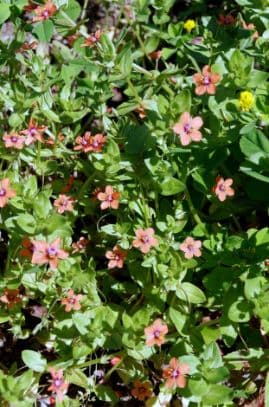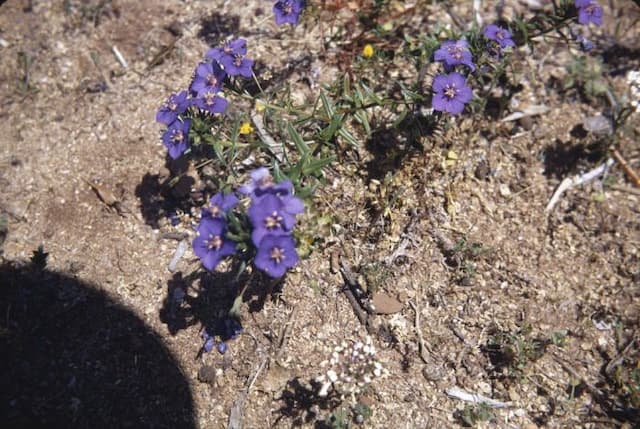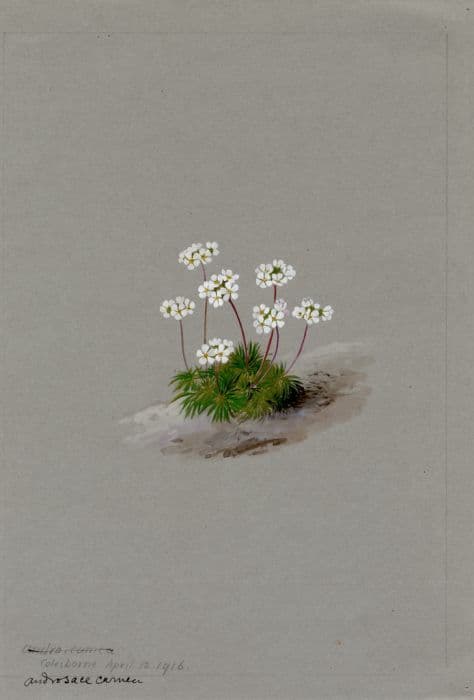Auricula Primula auricula 'Cinnamon' (Au/d)

ABOUT
Primula auricula 'Cinnamon' is a captivating ornamental plant renowned for its unique and colorful flowers. The blooms of this variety showcase a rich palette, where each flower typically presents a deep cinnamon hue that can be so intense it almost borders on a chocolate tone. This warm coloration is usually accentuated by a contrasting center, often a bright, striking yellow or lighter shade, giving the flowers an eye-catching appearance. The flowers are borne in clusters above the foliage, forming an attractive display when in full bloom. Each individual flower is composed of several rounded petals that form a circular shape, with the edges sometimes appearing slightly frilly or wavy, adding to its charm. The foliage of 'Cinnamon' consists of compact rosettes of leaves that are lush and smooth, often showing a slightly thickened texture which gives the plant a robust quality. The leaves are typically a deep green, which provides a perfect backdrop for the dramatic blossoms and enhances the overall visual impact of the plant. The overall impression of Primula auricula 'Cinnamon' is one of rich, indulgent color and a classic, yet distinctly unique floral form that makes it a popular choice among garden enthusiasts and a treasured addition to any garden that seeks a touch of spice and vibrancy.
About this plant
 Names
NamesFamily
Primulaceae
Synonyms
Auricula, Bear's Ear, Mountain Cowslip, Cinnamon Auricula
Common names
Primula auricula 'Cinnamon' (Au/d).
 Toxicity
ToxicityTo humans
Bear's ear, as Primula auricula 'Cinnamon' is commonly known, has low toxicity to humans. While not considered highly toxic, ingesting parts of the plant can cause mild symptoms such as nausea, vomiting, or diarrhea. Skin contact with the plant may sometimes result in a rash or irritation due to its primin content, a chemical component that can cause contact dermatitis in sensitive individuals. It is recommended to avoid ingesting any part of the bear's ear and to handle with care if you have sensitive skin.
To pets
Bear's ear is also considered to have low toxicity to pets. Although not typically dangerous, ingestion of the plant can lead to mild gastrointestinal upset in animals, including symptoms like vomiting and diarrhea. As with humans, skin contact might cause dermatitis in sensitive pets due to the primin content. Caution is advised to prevent pets from consuming the plant or rubbing against it excessively.
 Characteristics
CharacteristicsLife cycle
Perennials
Foliage type
Evergreen
Color of leaves
Green
Flower color
Yellow
Height
6 inches (15 cm)
Spread
6 inches (15 cm)
Plant type
Herb
Hardiness zones
5
Native area
Alps
Benefits
 General Benefits
General Benefits- Ornamental Value: Auricula adds visual appeal to gardens with its distinct cinnamon-colored flowers and lush foliage.
- Low Maintenance: Once established, this variety of Primula requires minimal care, making it ideal for busy gardeners.
- Long Blooming Period: The Auricula typically enjoys a prolonged blooming season, providing color and interest for an extended time.
- Cold Tolerance: Hardy in many climates, it can survive and thrive in cooler temperatures.
- Attracts Pollinators: The vibrant blooms attract butterflies and bees, which are beneficial for pollination of gardens.
- Container Gardening: Suitable for pots and containers, it allows those with limited space to enjoy its beauty.
- Versatility: Can be used in mixed flower borders, rock gardens, or as part of a woodland garden setting.
- Non-Invasive: Unlike some plant species, Auricula tends to stay in its designated space without spreading aggressively.
 Medical Properties
Medical PropertiesThis plant is not used for medical purposes.
 Air-purifying Qualities
Air-purifying QualitiesThis plant is not specifically known for air purifying qualities.
 Other Uses
Other Uses- Auricula theatres – Auriculas like Primula auricula 'Cinnamon' are often displayed in specially designed wooden shelving units, known as auricula theatres, which were a trend in the Victorian era and can be a charming addition to a period garden.
- Educational tools – Due to their unique genetic properties and variation, auriculas can be used in schools or educational programs to teach students about plant genetics, hybridization, and biodiversity.
- Photography subject – With their striking appearance, auriculas can be a favorite subject for botanical photographers and artists looking to capture their beauty and intricate patterns.
- Botanical illustration – The detailed forms and colors of auriculas make them excellent subjects for botanical illustrators practicing their art.
- Garden design – Auriculas are used to create interesting patterns and focal points in alpine rock gardens or as part of a cottage garden design.
- Floristry – Although not as common as other flowers, auriculas can occasionally be used in bespoke or artisanal floral arrangements.
- Color inspiration – The unique color combinations found on auriculas can inspire designers in various fields such as interior design, fashion, and graphic arts.
- Culinary decoration – The edible flowers of auriculas can occasionally be used as a decorative element on high-end desserts or in fancy cocktails, although this is not very common.
- Theme gardens – Auriculas can be included in historical or theme-based gardens to represent the gardening styles and interests of a particular era.
- Fragrance extraction – While not a major source, the subtle fragrance of some auriculas may be used in the crafting of niche perfumes or scented products.
Interesting Facts
 Feng Shui
Feng ShuiThe Auricula is not used in Feng Shui practice.
 Zodiac Sign Compitability
Zodiac Sign CompitabilityThe Auricula is not used in astrology practice.
 Plant Symbolism
Plant Symbolism- Unique Beauty: The Primula auricula, commonly known as Auricula, often represents the rare and unique beauty due to its distinct colors and patterns that can range from delicate pastels to deep, rich shades.
- Delicacy: This particular variety, 'Cinnamon', with its subtle hues can symbolize the fineness and grace that is often found in fragile or delicate objects.
- Patience: As Auriculas are perennials that bloom in spring, they can symbolize patience and the idea of waiting for beauty to manifest after a long winter.
- Pride: In the Victorian language of flowers, Auriculas were sometimes associated with pride due to their striking presence and the fact that they were highly prized by collectors.
- Strength in Adversity: Able to withstand cold temperatures and unpredictable climates, Auriculas can represent resilience and the ability to endure challenges.
 Water
WaterBear's Ear should be watered thoroughly, allowing the top inch of soil to dry out between waterings, typically every 7-10 days depending on the temperature and humidity. Provide it with about 16 ounces of water each time for small pots or up to 1-2 gallons for larger containers, ensuring that excess water can drain freely to avoid waterlogging. In the growing season, spring and summer, the plant may require more frequent watering, while in winter it needs less as the plant is dormant.
 Light
LightBear's Ear thrives best in bright, indirect light, avoiding direct afternoon sun which can scorch its leaves. A north-facing or east-facing window is ideal, providing gentle morning light or filtered afternoon light. If grown outside, dappled shade under trees or a similar protection is preferred to mimic its natural alpine habitat.
 Temperature
TemperatureBear's Ear prefers cooler conditions, thriving best between 50-60 degrees Fahrenheit. It can tolerate temperatures as low as the upper 40s, but should not be subjected to temperatures above 80 degrees, as it can suffer heat stress. Ideal temperature conditions are cool to mild, consistent with its native mountainous environments.
 Pruning
PruningBear's Ear requires pruning to remove dead or fading flowers to promote further blooming and to maintain plant shape. The best time for pruning is immediately after the bloom cycle, typically in late spring or early summer. Pruning can be done every year or every other year to rejuvenate the plant and encourage lush growth.
 Cleaning
CleaningAs needed
 Soil
SoilAuricula Primrose prefers well-draining, evenly moist soil with a slightly acidic to neutral pH of about 6.0 to 7.0. A good soil mix for Auricula Primrose would be composed of one part loam, one part leaf mold or peat, and one part perlite or grit to enhance drainage.
 Repotting
RepottingAuricula Primrose should be repotted annually to refresh the soil and accommodate growth. The best time to repot is in late summer after blooming or in early autumn.
 Humidity & Misting
Humidity & MistingAuricula Primrose thrives in moderate humidity levels. They prefer humidity ranging from 50% to 60%, avoiding excessively dry conditions.
 Suitable locations
Suitable locationsIndoor
Place in bright, indirect light and keep soil moist.
Outdoor
Choose partial shade and protect from harsh elements.
Hardiness zone
3-8 USDA
 Life cycle
Life cycleThe Auricula, specifically the Primula auricula 'Cinnamon' (Au/d), begins its life cycle as a seed, which germinates in moist, well-drained soil under conditions which mimic its native alpine environment, usually in spring or summer. Once the seeds sprout, the seedling stage follows, where the first true leaves develop and photosynthesis begins. As the plant enters the vegetative stage, it grows a rosette of fleshier leaves and establishes a strong root system. Following this, the Auricula enters its reproductive stage, typically in the spring when it produces vividly colored, fragrant flowers that attract pollinators and enable sexual reproduction. After pollination, the flowers develop into capsules containing numerous tiny seeds, completing the reproductive cycle. The plant may then enter a dormancy phase during harsher conditions, only to resume growth once favorable conditions return, or in some cases, it may die back, leaving seeds to continue its lineage.
 Propogation
PropogationPropogation time
Spring-Early Summer
Primula auricula 'Cinnamon', commonly known as Auricula, is often propagated through division, a method typically done in late summer after the flowering period has ended. This popular method involves gently lifting the plant from the soil and carefully separating the offsets, which are small clone plants that grow at the base of the parent plant, usually with their own set of roots. It's essential to use a clean, sharp knife or spade to divide the offsets to ensure a clean cut that will heal quickly. Once separated, the offsets should be replanted in well-draining soil at the same depth they were originally growing and watered well. They require a shady to partly sunny location to flourish, mimicking their natural alpine habitat. Division helps to rejuvenate older plants that may be losing vigor and is an excellent way to make more plants for the garden or for sharing with fellow garden enthusiasts.









